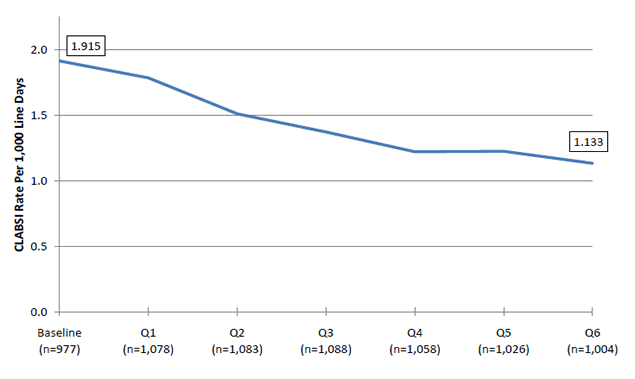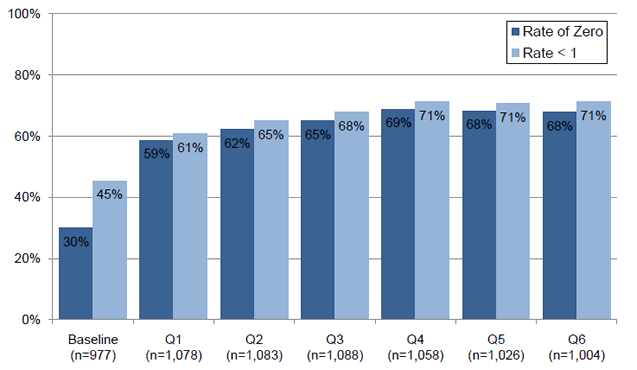Health care-associated infections (HAIs) result in almost 100,000 deaths each year and cost the U.S. health system $40 billion annually. Most of these deaths and costs are preventable. The U.S. Department of Health and Human Services' National Initiative to Reduce Healthcare-Associated Infections focuses on the need to dramatically reduce these infections. As part of this initiative, the Agency for Healthcare Research and Quality (AHRQ) funded a national effort to prevent central line-associated bloodstream infections (CLABSI) in U.S. hospitals beginning in 2008: On the CUSP: Stop BSI. AHRQ designed this project to replicate a highly successful State-based initiative in all 50 States, the District of Columbia and Puerto Rico. AHRQ's project goals were the reduction of CLABSIs to 1 per 1,000 central line days and to improve unit safety culture in intensive care units (ICUs) and non-ICUs. This final report summarizes project outcomes and lessons learned.
On the CUSP: Stop BSI was led by a unique partnership—the Health Research & Educational Trust (HRET) of the American Hospital Association, the Johns Hopkins Medicine Armstrong Institute for Patient Safety and Quality1 (Armstrong Institute), and the Michigan Health & Hospital Association's Keystone Center for Patient Safety & Quality (MHA Keystone). HRET managed the national effort. The Armstrong Institute created an effective change package that consisted of two components: technical, evidence-based practice; and an adaptive, innovative, hospital unit-based patient safety program. MHA Keystone originally applied this change package to dramatically reduce CLABSIs in Michigan, and the Michigan experience formed the basis of On the CUSP: Stop BSI. HRET, the Armstrong Institute, and MHA Keystone comprised the National Project Team (NPT), which oversaw all aspects of the national program.
The national program was organized and implemented as a State- or region-level collaborative, structured around the hospital association in the State or region2, with centralized education, data collection, and program management functions provided by the NPT. Recruitment of States began in 2008. Once hospital associations agreed to participate in the 2-year program, they were assigned to a group or cohort with other States/regions that began the program at the same time. At the State/regional level, hospital associations or State sponsors recruited and coordinated efforts with member hospitals and assigned a lead staff person, most often the senior quality manager in the association, to become the "State lead" to work directly with ICU and non-ICU teams, as well as the NPT. The State or regional association was also encouraged to invite State health departments, Quality Improvement Organizations (QIOs) and other State-based quality improvement and HAI prevention organizations to collaborate in the program and to help ensure coordination of HAI reduction activities.
Participating in a total of 6 cohorts were 44 States, the District of Columbia, and Puerto Rico. Collectively, these States and regions recruited more than 1,000 hospitals and 1,800 hospital units to participate in the project. Twenty-three States began the project in 2009, 12 States and the District of Columbia began during 2010, and 9 States and Puerto Rico began the effort in 2011.
On the CUSP: Stop BSI succeeded in reducing CLABSI nationwide. Analysis of available adult ICU data indicates that States reduced their rate from a baseline of 1.915 infections per 1,000 line days to one of 1.133 infections, or a relative reduction of 41 percent. The percentage of units with zero CLABSIs for at least one quarter increased from 30 percent at baseline to 68 percent at quarter six. Participating non-ICU and pediatric units had similar, impressive reductions in CLABSI rates. States that started with low CLABSI rates achieved additional improvements, again demonstrating that "getting to zero" was possible, a notion clinicians had not accepted until recently.
Adult ICU CLABSI Rate Overall Over Time

Percentage of Reporting Units with CLABSI Rate of 0/1,000 or Less than 1/1,000 CL

On the CUSP: Stop BSI is estimated to have saved an estimated 290 to 605 deaths assuming a 12-25 percent CLABSI mortality rate and an estimated $36,194,850 to $40,034,450 in excess costs averted, based upon a Centers for Disease Control & Prevention (CDC) estimate of $16,550 per CLABSI. A systematic review of the cost of CLABSI was completed and found the per-CLABSI cost may be higher than the published CDC estimate. Utilizing data from the systematic review, an estimated $97,756,628 to $244,270,620 in excess costs may have been averted, figures that are projected to continue to increase over time.
Project Summary of CLABSIs Prevented, Deaths Prevented and Excess Costs Averted Using CDC Estimates*
| CLABSIs Prevented | Deaths Prevented* | Excess Costs Averted* | |
|---|---|---|---|
| Mortality Rate 12% |
Mortality Rate 25% |
||
| 2,187 | 262 | 547 | $36,194,850 |
| 2,419 | 290 | 605 | $40,034,450 |
Project Summary of Excess Costs Averted Using Literature Estimates
| Prevented | Excess Costs Averted (in millions) | ||
|---|---|---|---|
| CLABSIs | Deaths* | Mean | Range |
| 2,419 | 290 - 605 | $171 M | $97 M - $244 M |
Drawing from their experiences, the On the CUSP: Stop BSI national project team and the State leaders identified five key lessons learned about how to implement a large, national quality improvement project:
- Have well-defined, evidence-based interventions.
- Build a solid implementation structure and project plan.
- Collect and use timely, accurate, and actionable data to improve performance.
- Tailor national program for local and unit audiences.
- Evolve project strategies and emphases over time.
The lessons learned contributed to the project's success and can be applied to future large scale interventions.
1. Formerly known as the Johns Hopkins University Quality Safety & Research Group.
2. Sometimes, the program was structured around a State sponsor as in the case of Hawaii.



